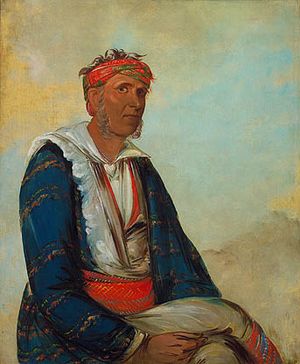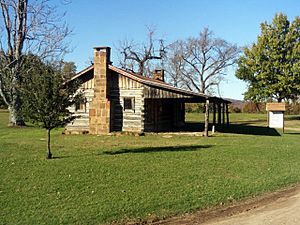John Jolly facts for kids
Quick facts for kids
John Jolly
|
|
|---|---|
| Ahuludegi, Oolooteka | |

Ahuludegi, also known as John Jolly; oil on canvas by George Catlin, 1834
|
|
| Cherokee Nation–West leader | |
| Preceded by | Tahlonteeskee |
| Succeeded by | John Looney |
| Personal details | |
| Died | 1838 Webbers Falls, Oklahoma |
| Relations | Brother, Tahlonteeskee; Sister, Jenny Due; Nephews, John Rogers, John Rogers Jr.; Niece, Tiana Rogers, (wife of Sam Houston) |
| Known for | Cherokee Leadership; first leader of the Old Settlers |
John Jolly (in Cherokee: Ahuludegi), also known as Oolooteka, was an important leader of the Cherokee people. He led them in Tennessee, the Arkansas Territory, and later in the Indian Territory, which is now Oklahoma. After 1818, he became the Principal Chief. When the tribal government was reorganized, he was made president of the Cherokee Nation–West.
John Jolly was a successful businessman. He owned a large farm, raised cattle, and was a merchant. He lived a life similar to wealthy Southern farmers of his time.
He became a close friend and father figure to Sam Houston. Houston first met Jolly as a teenager. He had left his family and was welcomed by Jolly. Houston later helped the Cherokee with treaties and their move to Arkansas. Jolly also offered Houston a safe place to stay after a difficult time in his life.
Contents
John Jolly's Early Life in Tennessee
John Jolly was born in Tennessee. His family had both Cherokee and European heritage. He ran a successful trading post on Hiwassee Island. This island is located where the Tennessee River and Hiwassee River meet. Today, it is in Meigs County.
He was a wealthy farmer. He often wore traditional buckskin shirts, leggings, and moccasins. Jolly was known for being friendly and calm. He worked hard to help the Cherokee people succeed. He encouraged them to use new technology and get an education. John Jolly did not speak English, but he likely understood it. He also knew another tribal language and French.
He became the leader of a group of Cherokee farmers in Tennessee. This happened after his brother, Tahlonteeskee, moved west in 1809. His brother moved after the United States bought the Louisiana Purchase in 1803.
Sam Houston Joins the Cherokee
In 1809, a young Sam Houston came to live with the Cherokee on Hiwassee Island. John Jolly adopted him and treated him like his own son. Jolly gave Houston the Cherokee name Ka'lanu, which means 'the Raven'.
Houston later went back to his family in Maryville, Tennessee. But he returned to live with the Cherokee in the west in 1829.
Moving West to Arkansas Territory
John Jolly's brother, Tahlonteeskee, settled with other Cherokee in what is now northeast Arkansas. After a treaty in 1817, Tahlonteeskee and his followers moved again. They settled in central Arkansas, along the Arkansas River. They were given land equal to what they had owned east of the Mississippi River. The Cherokee land was north of the Arkansas River.
In 1818, John Jolly and his followers left Tennessee. They traveled by riverboat with supplies and rifles. They moved to the Arkansas Territory. They settled along the Arkansas River near Spadra, Arkansas. When they arrived, they found that their new land was also the hunting grounds of the Quapaw and Osage people. This led to conflicts. Fort Gibson was built to protect the Cherokee. They also faced pressure from white settlers moving into the area.
Jolly saw that Native American tribes were being pushed further west. He believed that the tribes should unite. He hoped they could form the "United Tribes of America." He thought this would help "preserve the sinking race of Native Americans from extinction."
A Successful Farmer and Leader

John Jolly had a large farm with many fields and peach orchards. About twelve enslaved people worked on his farm. He also owned more than 500 cattle. He was known for being a very generous host. Many visitors came to his large, beautiful house. One visitor was the naturalist Thomas Nuttall. Jolly also stayed in touch with Indian agents, who were government representatives.
Near Jolly's house was the Dwight Mission. This mission was run by a missionary named Cephas Washburn. John Jolly supported the mission.
Some Cherokee families lived much like wealthy Southern farmers. They used enslaved African Americans for labor. They bought nice goods, clothes, and furniture from big cities like Baltimore and Philadelphia. They built homes that looked like the grand mansions of the South. However, they still kept their own cultural traditions. For example, Sam Houston and John Jolly shared food from a common spoon. This was an old tradition among friends.
Jolly was popular with both wealthy Cherokee families and full-blooded Cherokee. The wealthy families often had mixed Cherokee and European backgrounds. Their lives were similar to Southern farmers. The full-blooded Cherokee often did not trust white people. They wanted to keep their culture and heritage strong.
Becoming Principal Chief
John Jolly was elected Principal Chief of the Cherokee Nation—West. This happened after his brother Tahlonteeskee died in the spring of 1819. As Principal Chief, Jolly managed the affairs of the Cherokee people. He also dealt with government officials on diplomatic issues. This included important treaties between the Cherokee and the United States government.
Serving as President
In 1824, the tribal government was reorganized. John Jolly was then elected president of the Arkansas Cherokee. He worked with Arkansas territorial leaders and officials in Washington D.C. He focused on treaty rights and the safety of his people. There was pressure on the Cherokee to give up their land. More Americans were settling in the western parts of the United States.
Jolly wrote to George Izard, the governor of Arkansas. He wanted to stop a rumor that the Cherokee were interested in selling their land. He also told the governor that the U.S. government had not paid all the money promised in the 1817 treaty.
Life in Oklahoma
In 1828, most of the western Cherokee moved again. They went from the Arkansas Territory to the new Indian Territory. This area is now in Oklahoma. John Jolly started a new farm where the Arkansas and Illinois Rivers meet. This was near what is now Webbers Falls, Oklahoma.
During Jolly's time as leader, the Cherokee Nation—West adopted a new constitution. This constitution set up a government with three parts. It was similar to the one adopted by the Cherokee Nation—East in 1827. Jolly also established a capital city called Tahlonteeskee. He named it to honor his brother.
Some say that much of Jolly's success came from the advice and support of John Rogers. Rogers was his brother-in-law and another important Cherokee leader.
In 1829, Sam Houston came back to live with Jolly. Houston had a brief marriage and then resigned as governor of Tennessee. Jolly kept track of when steamboats arrived at Fort Gibson. He met Houston, his adopted son whom he called Raven, with many of his enslaved men carrying torches. Jolly was very happy Houston returned. He was glad to offer him a safe place. He also knew Houston could help the Cherokee speak with the government. Jolly told Houston: "My home is yours—my people are yours—rest with us."
The artist George Catlin painted John Jolly's portrait in 1834. Catlin described him as "a dignified chief." He noted that Jolly seemed to have a mix of white and Native American heritage. Catlin also mentioned that about six or seven thousand Cherokee people had moved with Jolly from Tennessee.
Black Coat, who served as Jolly's Second Chief, passed away in the spring of 1835. Joseph Vann then took his place.
John Jolly continued to serve as chief until he died in December 1838. He passed away near Webbers Falls, Oklahoma. His assistant principal chief, John Looney, became the new leader.
Legacy
Hiwassee Island, where the Hiwassee River meets the Tennessee River, was often called "Jolly's Island." This was in honor of the Cherokee leader. People in the area sometimes still use that name today.
See also


